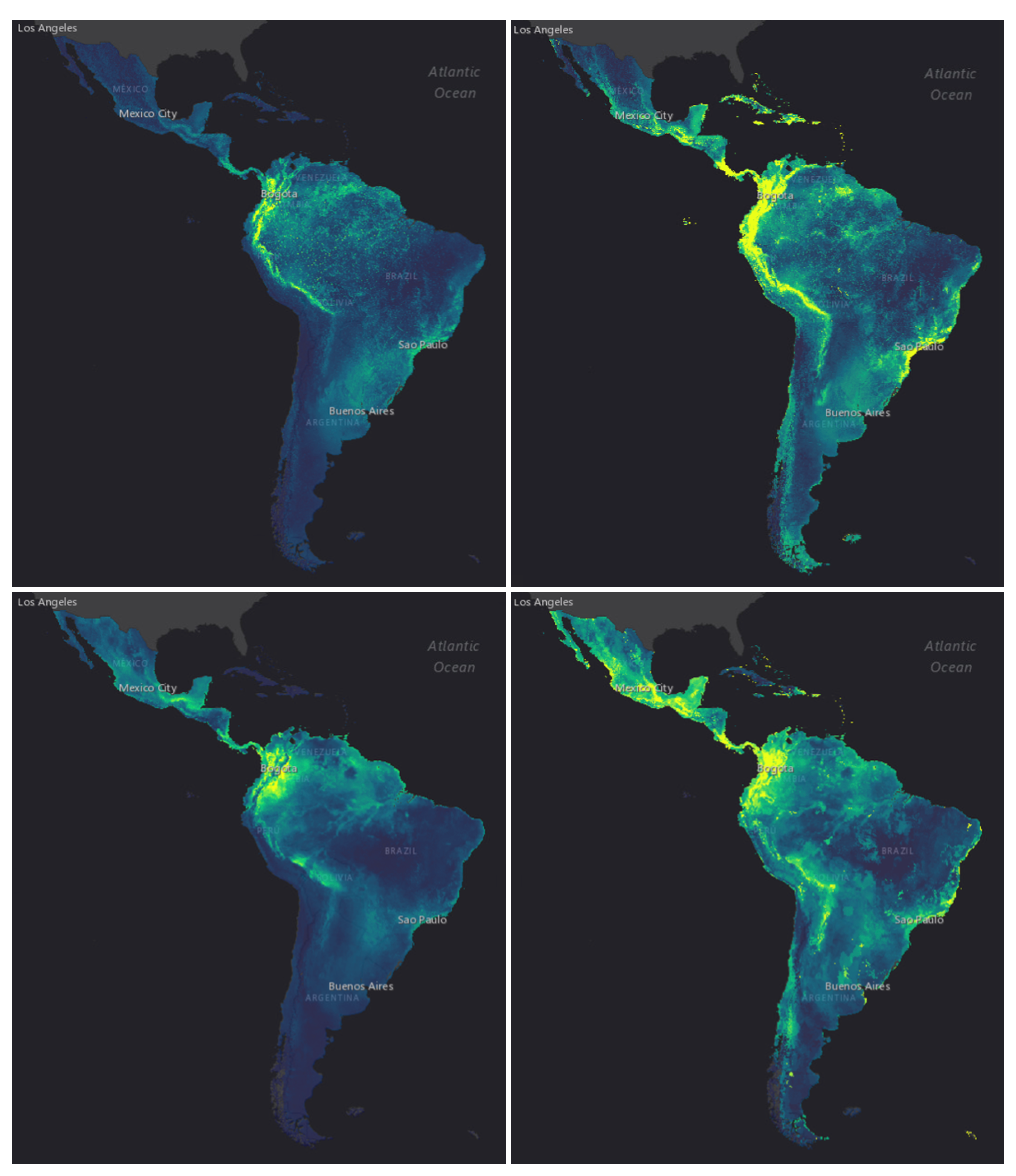Updates to the Half-Earth Project Map include a new 1-kilometer resolution for species richness and rarity layers in Central and South America, the Caribbean, and Southeast Asia, protected area additions to global priority layers, a new global tree layer, and new monitoring, reporting, and planning tools to support countries to achieve 30×30 commitments.


Durham, NC – As almost 200 nations prepare to gather for next month’s United Nations Conference on Biological Diversity (COP16) in Cali, Colombia, progress is on the minds of many worldwide. As the global community transitions from agreement to action, countries will report on their advancements toward the goals and targets of the Kunming-Montreal Global Biodiversity Framework (GBF) in the two years since its groundbreaking adoption.
In support of these efforts, the E.O. Wilson Biodiversity Foundation’s Half-Earth Project is announcing a suite of new data and features available on the Half-Earth Project Map. Building on previous innovations, the Half-Earth Project Map continues to expand the availability of large-scale species data across regions, including unprecedented 1-kilometer resolution richness and rarity layers for mammals, birds, reptiles, and amphibians across Southeast Asia. Mammal and bird data layers from Central and South America and the Caribbean provide a complete picture of the entire western hemisphere, and new global layers for more than 46,000 tree species highlight new areas important for conservation. Updates to global priority layers (10 in total, terrestrial and marine) also factor in the recent additions to the world’s protected area network.
Together, these resources provide decision-makers and practitioners from around the world with access to more detailed species information, supporting efforts to meet 30×30 commitments, among other GBF targets. These features and others will be presented and discussed during the 8th annual Half-Earth Day, set to take place alongside COP16 in-person and virtually, on Tuesday, October 22.
Knowledge for Life: Leveraging Knowledge to Support Global Species Conservation will convene scientists, community leaders, and conservation advocates from around the world. This year’s event will uplift the importance of integrating diverse knowledge sources and types in conservation decision-making, providing examples of current approaches to this integration as countries begin COP16 negotiations.


(Lower Left) Mammal Diversity: richness and (Lower Right) Total Rarity: based on 1-kilometer resolution distribution predictions for about 1,200 mammal species.
From South America, Nature & Culture International, Women for Conservation, Conservation International, and Natura Argentina will share insights on how knowledge and data support communities, civil society, and governments to achieve 30×30 goals at the sub-national level while incorporating access, inclusion, representation, and equity.
From Africa, the Democratic Republic of the Congo’s Institut Congolais pour la Conservation de la Nature (ICCN) and the E.O. Wilson Biodiversity Foundation’s Half-Earth Project partners will demonstrate how working collaboratively with governments and local partners to co-develop nationally relevant dashboard tools increases the efficiency and accuracy of field-level data collection, integrates public and private data, and expands monitoring and reporting capacity in countries where it is most needed.


The Half-Earth Project’s partners at Yale Center for Biodiversity and Global Change and the E.O. Wilson Biodiversity Foundation will also release the first annual Species Protection Index Report at Half-Earth Day. The Species Protection Index (SPI) is a component indicator under Target 3 of the GBF and is the only Target 3 indicator to be species-specific and spatially quantitative.
The report will highlight 2024 marine and terrestrial SPI values at regional, national, and sub-national scales, along with case studies of conservation success and remaining gaps in species protection. It will be published annually to reflect updates in SPI values globally and highlight additions to the SPI workflow. This annual frequency will support global monitoring of trends in SPI values over time, allowing for more targeted efforts in regions and species with remaining gaps and increased recognition of countries and organizations driving positive impact in global species conservation.
Half-Earth Day will also focus on the importance of sub-national areas for species protection, such as areas in the Ecuadorian Amazon that host more than a third of the country’s vertebrate species, including 80 threatened with extinction.
“By filling in gaps that national areas don’t cover, regional, provincial, and even municipal protected areas are critically important for the global community to reach our ambitious 30×30 biodiversity goals,” says Matt Clark, President and Executive Director of Nature & Culture International, a speaker at Half-Earth Day.
Half-Earth Day will be capped off by a Keynote Conversation, with Wade Davis, Cristián Samper, and Carmen Guerra, to discuss how Colombia has uniquely nurtured their connection with nature and how that knowledge can inform our lives and livelihoods aligned with the COP16 theme of Peace with Nature.
——-
Data Sources: Half-Earth Project Map – E.O. Wilson Biodiversity Foundation (2024), Map of Life – Yale University (2024), World Database on Protected Areas (2024), World Database on Other Effective Area-Based Conservation Measures (2024), Guo et al. (2022), Serra-Diaz et al. (2017)
About Half-Earth Day
Half-Earth Day® convenes people from around the world and across disciplines to share their perspectives and provide thought leadership on how we can work together to safeguard biodiversity and ensure the health of our planet for future generations. This year’s Half-Earth Day event is co-hosted by the E.O. Wilson Biodiversity Foundation and the Humboldt Institute. Participation is free with registration. Half-Earth Day 2024 is made possible by the generous support of ADM and the John D. and Catherine T. MacArthur Foundation, with additional support from Nature & Culture International, and other partners and sponsors.
About the E.O. Wilson Biodiversity Foundation
The E.O. Wilson Biodiversity Foundation’s mission is to reimagine the way we care for our planet. The Foundation’s major initiative, the Half-Earth Project, is working to inspire informed collective action to save the biosphere. Visit www.eowilsonfoundation.org to learn more.

